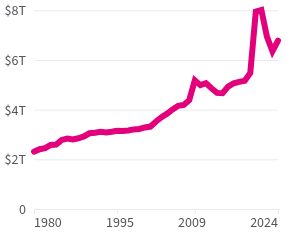How does the government budget process work?
Congress hasn't passed a full budget on time since 1997. How is the government getting funded?
Government budgeting is a massive project. Each year, the federal government takes in trillions of dollars and redistributes them (and, in most years, more) to fund government programs and address the current administration’s priorities.
At USAFacts, we talk a lot about budget outcomes — how the government spends its money and what that means for the American people. But the process itself is a whole other issue, one itself that leads to political tensions, potential government shutdowns, and ultimately, a plan for the financial future of the country.

How is the budget process structured?
While mandatory spending is required by law and isn't subject to annual Congressional approval, discretionary government spending is updated with new legislation annually (though in recent years, budget legislation has been more ad hoc).
What are continuing resolutions?
Here’s the catch — for all of the 21st century, Congress has not met the appropriations deadlines and most federal funding has happened through continuing resolutions. These bills provide temporary financial coverage for government programs until regular appropriations bills are passed, so the government can function and avoid a shutdown in the interim.
Continuing resolutions have covered some or all appropriations in every fiscal year since 1997, and in 46 of the last 49 fiscal years overall.
Congress last passed a full budget in 1997.
Total appropriation bills passed by the end of the fiscal year, 1977–2025
Presidential budget request
The process is structured to begin with the president. Every year, Congress asks the president to submit a budget request by the first Monday in February. This budget is compiled by the Office of Management and Budget (OMB), a subdivision of the Executive Office of the President, with input from the various executive agencies. This process usually takes 9+ months.
Congressional budget resolution
Once the request is in Congress’s hands, budget committees in both the House and Senate hold hearings. The upshot of these hearings is a budget resolution (also called a concurrent resolution), made by April 15, setting spending levels by committee for the next fiscal year and planning levels for at least the next five. This resolution isn’t law, but it creates a framework for the spending legislation that Congress will enact later in the year.
Sometimes this resolution proposes a budget that would require changes to law — for instance, changing mandatory spending or increasing the debt limit. When this is the case, Congress must also pass bills called reconciliation bills by June 15. These bills change the laws necessary to eventually pass a budget that can meet the outline set forth by the resolution.
Appropriation bills
Next up is the work of the House and Senate Appropriations Committees, which draft the legislation that will enact the budget levels into law. Each chamber’s appropriations committee has 12 subcommittees:
- Agriculture, Rural Development, Food and Drug Administration, and Related Agencies
- Commerce, Justice, Science, and Related Agencies
- Defense
- Energy and Water Development, and Related Agencies
- Financial Services and General Government
- Homeland Security
- Interior, Environment, and Related Agencies
- Labor, Health and Human Services, Education, and Related Agencies
- Legislative Branch
- Military Construction, Veterans Affairs, and Related Agencies
- State, Foreign Operations, and Related Programs
- Transportation and Housing and Urban Development, and Related Agencies
Each subcommittee drafts an appropriation bill for the spending related to their coverage area. These bills are presented to Congress in May and early June and finalized by June 30. If one or more of these bills isn’t in place by the end of the fiscal year in September, Congress has to pass a continuing resolution or run the risk of a government shutdown.
Read more about government spending and get the data straight to your inbox by signing up for our newsletter.
